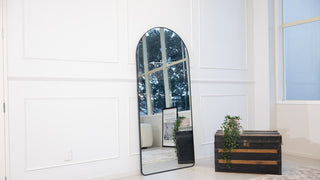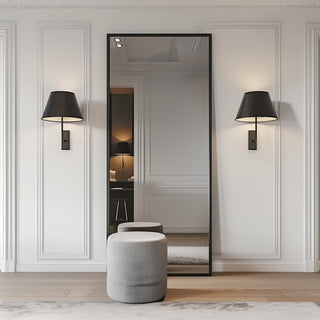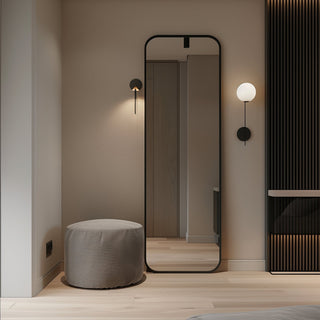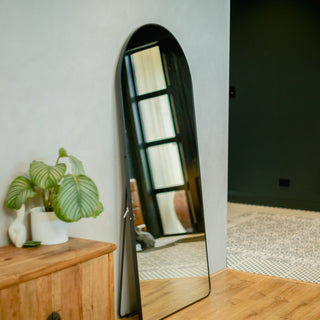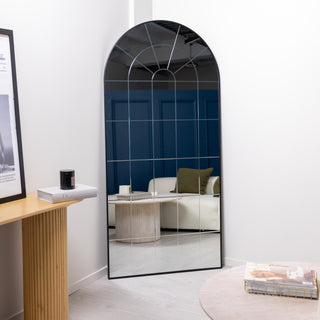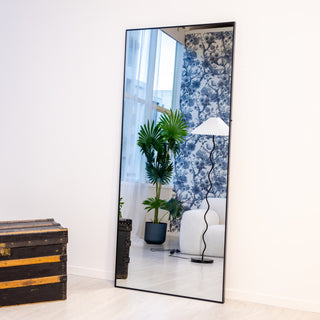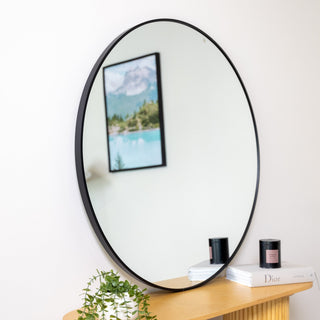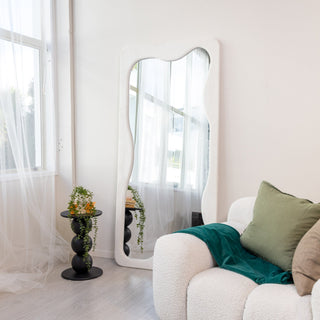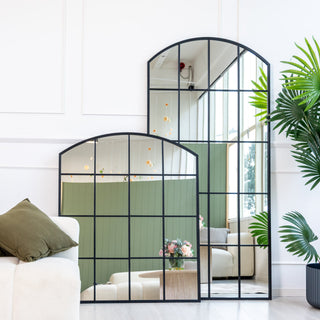Have you ever caught your reflection in a shop window and done a double-take, thinking, "Is that really me?" Or perhaps you've tried on an outfit in a retail changing room that looked absolutely perfect, only to feel a wave of disappointment when you see it in the mirror at home. It’s a common, slightly unsettling experience that can leave you questioning your own eyes, your clothes, and even your self-image.
The good news is, you’re not imagining it. And more importantly, it’s not you — it’s the mirror.
The subtle (and sometimes not-so-subtle) differences you see from one mirror to the next are not a trick of the light or a figment of your imagination. They are the direct result of the mirror's physical properties: its quality, its materials, its thickness, and the precision of its construction. A mirror is far more than a simple piece of glass; it is a finely crafted optical instrument. When it's made well, it reflects reality with perfect fidelity. When it's not, it can bend, warp, and distort that reality in frustrating ways.
In this comprehensive guide, we’ll pull back the curtain on the science of reflections. We will explore exactly why these distortions happen, how to spot a low-quality mirror, and why investing in a premium, well-crafted mirror is the key to seeing your true self and transforming your home.
The Deep Science Behind the Reflection: More Than Just Glass
A mirror’s primary function is to provide an accurate, one-to-one reflection of the world. Achieving this, however, is a marvel of physics and manufacturing precision. The process relies on light rays traveling from an object, bouncing off the mirror's surface, and returning to your eye in a perfectly preserved pattern. When a mirror fails to do this, it's almost always due to physical imperfections in its surface or structure.
Think of it like the surface of a pond. On a perfectly calm day, the water's surface is flat and still, providing a crystal-clear, perfect reflection of the sky and trees. But the moment a slight breeze creates ripples, the reflection becomes warped and distorted. The same principle applies to mirrors, albeit on a microscopic scale.
Glass Quality: The Foundation of Clarity
The absolute foundation of any high-quality mirror is a perfectly flat sheet of glass. The industry standard for this is "float glass," a manufacturing process where molten glass is poured onto a bed of molten tin. This method produces a sheet with a uniform thickness and an exceptionally flat, smooth surface, which is essential for a distortion-free reflection.
However, not all float glass is created equal. Cheaper mirrors often use thinner, lower-grade glass that can have microscopic bends, waves, or inconsistencies. Even a slight, imperceptible curve can act like a funhouse mirror. A subtle concave (inward) curve can elongate the reflection, making you appear taller and thinner, while a minor convex (outward) curve can compress it, making you seem shorter and wider. This is a known tactic in some retail environments to make clothes appear more flattering.
Glass Thickness: The Key to Stability
The thickness of the glass is also critically important for maintaining that perfect flatness over time. A thicker pane of glass is inherently more rigid and stable. It is far less susceptible to flexing, bowing, or warping due to its own weight, changes in temperature, or humidity. A thin, flimsy mirror, especially a large full-length one, can begin to sag or bend under its own weight when hung or leaned against a wall, introducing distortions that weren't there on day one. This is why a substantial, well-made mirror feels heavier and more robust—that heft is a direct indicator of its structural integrity and its ability to provide a lasting, true reflection.
The Reflective Coating: The Heart of the Mirror
The magic of a mirror happens in the ultra-thin reflective layer applied to the back of the glass. This process, often called "silvering," is what turns a transparent pane of glass into a reflective surface. While historically done with actual silver, modern high-quality mirrors typically use a layer of aluminum or other proprietary coatings applied in a vacuum.
The quality of this layer is paramount. A premium reflective coating is applied with perfect uniformity, ensuring it provides a bright, crisp, and colour-accurate image. Inferior coatings, or those applied unevenly, can result in a number of problems. The reflection might appear dull, dark, or slightly blurry, which affects how you perceive colour, light, and fine details. In the worst cases, moisture can penetrate the backing and cause the reflective layer to oxidize, leading to unsightly black spots or "mirror rot" that permanently ruins the reflection.
The Frame and Backing: The Unsung Heroes
While we often choose a mirror for its frame's style, the frame plays a crucial structural role. A weak, poorly constructed, or improperly fitted frame can put uneven stress on the glass, causing it to flex or bow and creating distortions. The frame must be strong enough to support the weight of the glass without twisting or bending over time.
Equally important is the backing board. A solid, protective backing seals the reflective layer from moisture and provides additional rigidity to the entire structure, ensuring the glass remains perfectly flat. This is an often-overlooked detail that separates a premium, long-lasting mirror from one that will degrade over time.
The C&F Creation Difference: Our Unwavering Commitment to a True Reflection
This deep dive into the science of mirrors highlights why being a factory-direct manufacturer is so important to us. We aren't just another online retailer; we are involved in the creation of our mirrors from start to finish. This gives us meticulous, end-to-end control over the entire process, allowing us to enforce the highest quality standards at every single stage.
- Our Factory-Direct Advantage: We begin by sourcing only premium, thick float glass, specifically chosen for its flawless flatness and optical clarity. We don't cut corners with thin, flimsy materials. Our "silvering" process uses high-grade reflective coatings applied with state-of-the-art equipment to ensure a bright, durable, and perfectly uniform finish. This is a stark contrast to many resellers who may not know the exact specifications or manufacturing standards of the mirrors they sell.
- A Spotlight on Superior Materials: Our commitment to quality extends to our frames. We chose Polystyrene for many of our designs, like the bestselling Le Beau Arched Window Full-Length Mirror | 190 x 90cm, for its unique combination of strength, lightness, and durability. It’s a modern material that is highly resistant to moisture, making it perfect for any room in a New Zealand home, including bathrooms. This ensures the frame won't warp or degrade, protecting the integrity of the glass for years to come.
- A Warranty That Means Something: We are so confident in our materials and our manufacturing process that we back every single mirror with a comprehensive 1-Year Warranty. This isn't just a marketing promise; it's our guarantee against the very defects and distortions we've discussed. It's our assurance to you that the mirror you bring into your home will reflect your style and your space with perfect, unwavering accuracy.
A Practical Guide: How to Spot a High-Quality Mirror and Choose the Perfect One
Now that you understand the science, how can you use it to make a smart purchase? Whether you're shopping online or in a store, here are the key things to look for to ensure you're getting a mirror that will provide a true reflection.
The "Wiggle Test"
If you can see a mirror in person, this is the most reliable test for distortion. Stand a few feet back and find a straight line in the reflection—a door frame, a window sill, or the pattern on the floor. Now, slowly move from side to side. In a high-quality mirror, that line will remain perfectly straight. If the line wiggles, curves, or bends as you move, the mirror has surface imperfections and will distort your reflection.
Examine the Reflection's Clarity
Look closely at the details. Is the reflection bright and sharp from edge to edge? Or does it seem slightly dim, blurry, or fuzzy, particularly near the corners? A high-quality mirror will have consistent, crystal-clear clarity across its entire surface.
Assess the Build Quality
A well-made mirror feels solid. Check the frame joints—are they seamless and strong? Is the backing board securely attached and made of a durable material? These are tangible signs of quality craftsmanship that indicate the mirror is built to last.
Size and Placement for Maximum Impact
The right mirror does more than just show your reflection; it transforms a room.
- Go Big for a Better View: A larger mirror, like our popular 180x80cm models, offers a complete head-to-toe view, which is essential for getting dressed. But beyond that, a larger surface is inherently more stable and better at creating a dramatic sense of space and light.
- Placement is Everything: To make a small room feel bigger and brighter, place a large mirror directly opposite a window. It will capture the natural light and reflect it back into the room, creating an incredible sense of openness. In an entryway or at the end of a hallway, a full-length mirror creates a welcoming focal point and the illusion of greater depth.
Conclusion: An Investment in Seeing Yourself and Your Home Clearly
The strange and often frustrating experience of looking different in different mirrors is not a mystery—it is a matter of physics and quality. The distortions created by cheap, thin glass and poor manufacturing are real, and they can subtly impact our confidence and our perception of our own homes.
Your mirror is one of the most personal and frequently used items in your space. It’s there when you start your day and when you prepare for a special night out. It should be a source of truth and confidence, reflecting you and your beautifully curated home with perfect clarity.
At C&F Creation, our mission is simple: to bring handcrafted, high-quality mirrors directly from our factory to Kiwi homes. By controlling every step of the process and using only premium materials, we ensure every mirror we sell provides a true, distortion-free reflection. As a proudly NZ-owned business, we stand behind our craftsmanship with a solid warranty and a commitment to your complete satisfaction.

